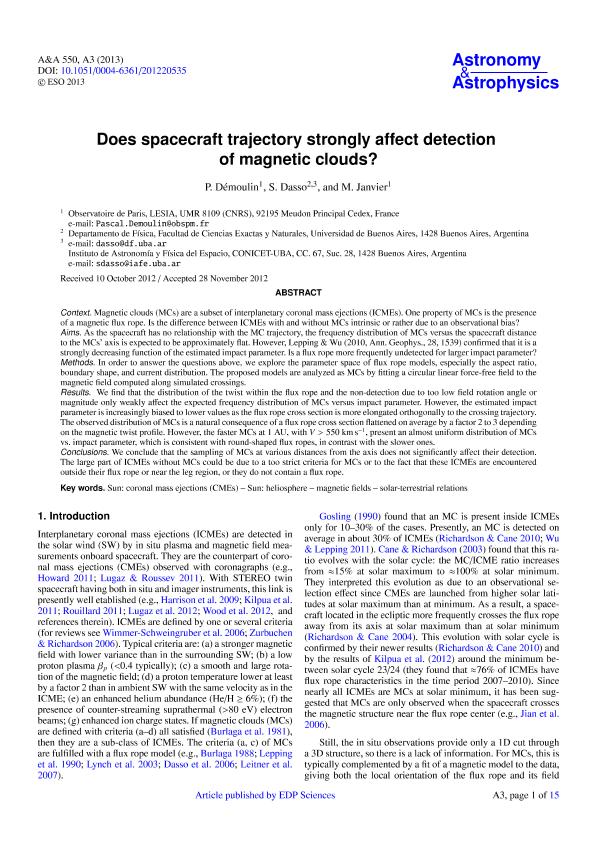Mostrar el registro sencillo del ítem
dc.contributor.author
Démoulin, Pascal

dc.contributor.author
Dasso, Sergio Ricardo

dc.contributor.author
Janvier, M.
dc.date.available
2017-05-29T15:05:11Z
dc.date.issued
2013-01
dc.identifier.citation
Démoulin, Pascal; Dasso, Sergio Ricardo; Janvier, M.; Does spacecraft trajectory strongly affect detection of magnetic clouds?; Edp Sciences; Astronomy And Astrophysics; 550; 1-2013; A3,1-15
dc.identifier.issn
0004-6361
dc.identifier.uri
http://hdl.handle.net/11336/17053
dc.description.abstract
Context. Magnetic clouds (MCs) are a subset of interplanetary coronal mass ejections (ICMEs). One property of MCs is the presence of a magnetic flux rope. Is the difference between ICMEs with and without MCs intrinsic or rather due to an observational bias?
Aims. As the spacecraft has no relationship with the MC trajectory, the frequency distribution of MCs versus the spacecraft distance to the MCs’ axis is expected to be approximately flat. However, Lepping & Wu (2010, Ann. Geophys., 28, 1539) confirmed that it is a strongly decreasing function of the estimated impact parameter. Is a flux rope more frequently undetected for larger impact parameter?
Methods. In order to answer the questions above, we explore the parameter space of flux rope models, especially the aspect ratio, boundary shape, and current distribution. The proposed models are analyzed as MCs by fitting a circular linear force-free field to the magnetic field computed along simulated crossings.
Results. We find that the distribution of the twist within the flux rope and the non-detection due to too low field rotation angle or magnitude only weakly affect the expected frequency distribution of MCs versus impact parameter. However, the estimated impact parameter is increasingly biased to lower values as the flux rope cross section is more elongated orthogonally to the crossing trajectory. The observed distribution of MCs is a natural consequence of a flux rope cross section flattened on average by a factor 2 to 3 depending on the magnetic twist profile. However, the faster MCs at 1 AU, with V > 550 km s-1, present an almost uniform distribution of MCs vs. impact parameter, which is consistent with round-shaped flux ropes, in contrast with the slower ones.
Conclusions. We conclude that the sampling of MCs at various distances from the axis does not significantly affect their detection. The large part of ICMEs without MCs could be due to a too strict criteria for MCs or to the fact that these ICMEs are encountered outside their flux rope or near the leg region, or they do not contain a flux rope.
dc.format
application/pdf
dc.language.iso
eng
dc.publisher
Edp Sciences

dc.rights
info:eu-repo/semantics/openAccess
dc.rights.uri
https://creativecommons.org/licenses/by-nc-sa/2.5/ar/
dc.subject
Sun: Coronal Mass Ejections (Cmes)
dc.subject
Sun: Heliosphere
dc.subject
Magnetic Fields
dc.subject
Solar-Terrestrial Relations
dc.subject.classification
Astronomía

dc.subject.classification
Ciencias Físicas

dc.subject.classification
CIENCIAS NATURALES Y EXACTAS

dc.title
Does spacecraft trajectory strongly affect detection of magnetic clouds?
dc.type
info:eu-repo/semantics/article
dc.type
info:ar-repo/semantics/artículo
dc.type
info:eu-repo/semantics/publishedVersion
dc.date.updated
2017-05-23T19:17:01Z
dc.journal.volume
550
dc.journal.pagination
A3,1-15
dc.journal.pais
Francia

dc.journal.ciudad
Paris
dc.description.fil
Fil: Démoulin, Pascal. Centre National de la Recherche Scientifique. Observatoire de Paris; Francia
dc.description.fil
Fil: Dasso, Sergio Ricardo. Consejo Nacional de Investigaciónes Científicas y Técnicas. Oficina de Coordinación Administrativa Ciudad Universitaria. Instituto de Astronomía y Física del Espacio. - Universidad de Buenos Aires. Facultad de Ciencias Exactas y Naturales. Instituto de Astronomía y Física del Espacio; Argentina
dc.description.fil
Fil: Janvier, M.. Centre National de la Recherche Scientifique. Observatoire de Paris; Francia
dc.journal.title
Astronomy And Astrophysics

dc.relation.alternativeid
info:eu-repo/semantics/altIdentifier/doi/http://dx.doi.org/10.1051/0004-6361/201220535
dc.relation.alternativeid
info:eu-repo/semantics/altIdentifier/url/https://arxiv.org/abs/1211.5343
dc.relation.alternativeid
info:eu-repo/semantics/altIdentifier/url/https://www.aanda.org/articles/aa/abs/2013/02/aa20535-12/aa20535-12.html
Archivos asociados
